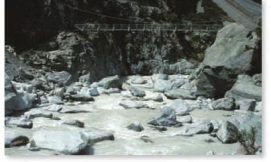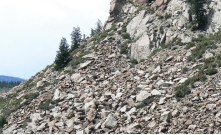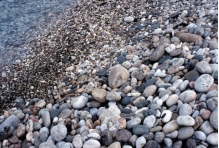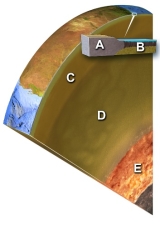A) The exposed rock may never weather thus never enter the rock cycle again.
B) Rock may be involved in a variety of processes in different sequences.
C) Some rocks are forever trapped in the magma of the Earth.
Correct Answer

verified
Correct Answer
verified
Multiple Choice
The uppermost part of the oceans, as expressed by normal ocean waves, are in constant motion due to the effects of the:
A) wind
B) ultraviolet radiation
C) gravity
D) tides
Correct Answer

verified
Correct Answer
verified
Multiple Choice
Based on this topographic profile across the central United States, which region probably has the thinnest crust? 
A) Colorado Rockies
B) Great Plains
C) Mississippi River
D) Appalachian Mountains
E) East Coast
Correct Answer

verified
Correct Answer
verified
Multiple Choice
Which of the following is true about gravity?
A) Gravity of the Sun and Moon exert a pull on Earth.
B) The mass of the Earth causes a downward pull on objects on Earth.
C) Gravity causes ice, water, and rocks to move downhill.
D) All of these.
Correct Answer

verified
Correct Answer
verified
Multiple Choice
According to the rock cycle, sediment that is being transported by a river could become a metamorphic rock after:
A) uplift and weathering
B) melting and solidification
C) deposition and burial
D) solidification and uplift
Correct Answer

verified
Correct Answer
verified
Multiple Choice
Choose appropriate ways) that volcanoes might impact people living nearby:
A) Releases steam and noxious gases into the atmosphere.
B) Volcanic ash provides fertile sediment for growing crops.
C) Ash ejected into the atmosphere blocks sunlight.
D) Projectiles thrown into the air can hit your house.
E) All of these impact people living nearby.
Correct Answer

verified
Correct Answer
verified
Multiple Choice
The Earth's orbit around the Sun is almost circular. Therefore, Earth receives about the same amount of year-round ________.
A) heat and light
B) heat and precipitation
C) light and precipitation
Correct Answer

verified
Correct Answer
verified
Multiple Choice
Which of the following does NOT list processes in an order consistent with a logical progression through the rock cycle?
A) weathering, erosion, deposition
B) solidification, melting, burial
C) erosion, deposition, burial
D) uplift, weathering, erosion
E) burial, metamorphism, melting
Correct Answer

verified
Correct Answer
verified
Multiple Choice
The most important agent for sculpting the landscape is: 
A) flowing water
B) blowing wind
C) gravity
D) wave action
Correct Answer

verified
Correct Answer
verified
Multiple Choice
Which layer in the earth is similar to the composition of granite?
A) continental crust
B) oceanic crust
C) upper mantle
D) lower mantle
E) core
Correct Answer

verified
Correct Answer
verified
Multiple Choice
Radioactive decay in the Earth, especially in the Earth's crust, creates a tremendous amount of:
A) pressure
B) heat
Correct Answer

verified
Correct Answer
verified
Multiple Choice
Which of these best describes the location of the core within the Earth?
A) The core is located in the central zone of the Earth, beneath the mantle.
B) The core is located between the thin surface crust and the thick mantle.
C) The core is located at the surface of the Earth, forming a thin skin.
Correct Answer

verified
Correct Answer
verified
Multiple Choice
Which of the following is NOT an important difference between continents and oceans?
A) thickness of the crust
B) composition of the crust
C) density of the crust
D) whether it is part of the lithosphere
E) elevation
Correct Answer

verified
Correct Answer
verified
Multiple Choice
Which of the following surface environments is the most likely site for deposits in this photograph? 
A) steep mountain front
B) river channel
C) sand dunes
D) beach
E) lake
Correct Answer

verified
Correct Answer
verified
Multiple Choice
What happens to a mountain in terms of isostatic adjustment following a period of significant erosion?
A) The continent underneath will be uplifted.
B) The continent underneath will subside.
C) Erosion does not affect isostasy.
Correct Answer

verified
Correct Answer
verified
Multiple Choice
Which arrows in this figure indicates evaporation? 
A) A
B) B
C) C
D) D
Correct Answer

verified
Correct Answer
verified
Multiple Choice
What type of rock would the materials shown in this photograph produce? 
A) sedimentary
B) igneous
C) metamorphic
D) hydrothermal
Correct Answer

verified
Correct Answer
verified
Multiple Choice
A type of rock that forms directly from precipitates of hot water is called an) :
A) hydrothermal rock
B) sedimentary rock
C) igneous rock
Correct Answer

verified
Correct Answer
verified
Multiple Choice
The main cause of the Rapid City flood of 1972 was:
A) rapid melting of glaciers in the Black Hills because of global warming
B) failure of a dam because of a large landslide into the reservoir
C) poor design and poor construction of a large concrete dam
D) intense rainfall from a thunderstorm that resulted in a flash flood
E) all of these
Correct Answer

verified
Correct Answer
verified
Multiple Choice
Which layer on this figure is the outer core? 
A) A
B) B
C) C
D) D
E) E
Correct Answer

verified
Correct Answer
verified
Showing 41 - 60 of 110
Related Exams